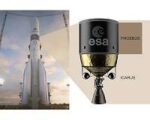A breakthrough in metal additive manufacturing has yielded a new aluminum alloy that combines exceptional strength with printability—potentially transforming how aircraft and defense systems are built. Developed by a research team at the University of California Santa Barbara (UCSB) in collaboration with the U.S. Air Force Research Laboratory (AFRL), the alloy outperforms existing printable aluminum materials and could enable lighter, more efficient aerospace structures.
Breaking Through the Strength Barrier in Printable Aluminum
Aluminum alloys are prized in aerospace for their low density and good corrosion resistance, but their use in additive manufacturing (AM) has been limited by poor mechanical performance when printed. Traditional high-strength aluminum alloys like 7075 or 6061 often crack during laser-based powder bed fusion (LPBF) printing due to thermal stresses and solidification issues.
The UCSB-AFRL team tackled this challenge by designing an alloy that remains stable during rapid solidification and resists cracking under AM conditions. The result is a novel composition based on a mix of aluminum with rare-earth elements such as scandium and zirconium—elements known to promote fine grain structures and prevent hot tearing. The researchers achieved an ultimate tensile strength of over 600 MPa (megapascals), exceeding that of most commercially available printable aluminum alloys like AlSi10Mg (~400 MPa).
“This alloy sets new benchmarks for strength while being fully compatible with laser powder bed fusion,” said Professor Tresa Pollock, lead author of the study published in Nature Communications. “It opens up new pathways for structural applications where weight savings are critical.”
Designing Alloys Specifically for Additive Manufacturing
The success of this alloy stems from a shift in design philosophy—engineering materials specifically for AM processes rather than adapting conventional wrought alloys. The team used computational thermodynamics to model phase stability and microstructure evolution during rapid cooling typical of LPBF.
Key innovations include:
- Scandium-Zirconium microalloying: These elements refine grain structure and reduce cracking susceptibility.
- Rapid solidification tolerance: The alloy avoids deleterious phases that typically form during fast cooling.
- Nano-scale precipitate strengthening: Fine dispersoids enhance yield strength without sacrificing ductility.
This approach mirrors strategies used in Scalmalloy—a well-known printable aluminum-scandium-magnesium alloy developed by Airbus subsidiary APWorks—but improves upon it with higher strength-to-weight ratios and potentially broader processability across different AM platforms.
Aerospace Applications: From UAVs to Hypersonics
The implications for aerospace and defense manufacturing are significant. Additive manufacturing already plays a growing role in producing complex geometries for satellites, UAVs, jet engines, and missile components. However, material limitations have constrained its use in load-bearing airframe parts or high-speed flight applications where mechanical properties are critical.
This new alloy could change that calculus:
- Lighter structural components: Higher specific strength enables mass reduction without compromising integrity.
- Conformal cooling channels: Complex internal geometries can be printed directly into heat exchangers or engine parts.
- Rapid prototyping of flight hardware: Defense programs can iterate faster using mission-ready materials without tooling delays.
The U.S. Department of Defense has increasingly invested in AM capabilities through initiatives like America Makes and DARPA’s Open Manufacturing program. This alloy aligns well with those efforts to accelerate digital production pipelines while maintaining performance standards required for military platforms such as sixth-generation fighters or hypersonic glide vehicles.
Sourcing Rare Elements: A Strategic Bottleneck?
A key caveat is the reliance on rare-earth elements like scandium—a material both expensive and geopolitically sensitive. Global scandium production is limited (~15–20 tonnes/year), with dominant sources located in China, Russia, Ukraine, and Australia. This raises concerns about supply chain resilience if adoption scales up across defense OEMs or commercial aviation manufacturers like Boeing or Airbus.
The AFRL-UCSB team acknowledges this constraint but notes ongoing efforts to reduce scandium content via alternative microalloying strategies or recycling from scrap streams. Moreover, the U.S. government’s Critical Minerals Strategy identifies scandium as a priority element for domestic sourcing initiatives under the Defense Production Act Title III framework.
Toward Certification and Industrial Adoption
The next hurdle is transitioning from lab-scale validation to industrial qualification—a multi-year process involving fatigue testing, corrosion analysis, weldability studies, and certification under ASTM/AMS standards required by aerospace regulators like FAA or DoD agencies such as NAVAIR or USAF Life Cycle Management Center (LCMC).
If successful, this printable alloy could be adopted into supply chains supporting platforms such as:
- B-21 Raider stealth bomber: weight-sensitive airframe components requiring high fatigue resistance;
- XQ-58A Valkyrie UCAV: low-cost drone structures benefiting from low-mass fabrication;
- SABRE combined-cycle engines: thermal management systems needing conformal metallic heat sinks;
The research team is currently collaborating with industrial partners through Cooperative Research Agreements (CRADAs) facilitated by AFRL’s Materials & Manufacturing Directorate at Wright-Patterson AFB.
A Material Enabler for Next-Gen Aerospace Systems
This development underscores how tailored materials science—combined with advanced manufacturing—can unlock performance gains not achievable through legacy methods alone. As additive manufacturing matures beyond prototyping into full-rate production roles within defense industrial bases, materials like this printable high-strength aluminum will be pivotal enablers of next-generation capabilities across airpower domains.
The convergence of computational metallurgy, strategic resource planning, and digital design workflows marks a new era where engineering constraints can be redefined—not just optimized—for mission advantage.










